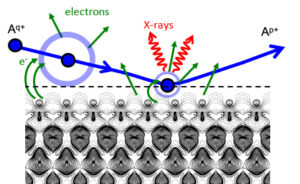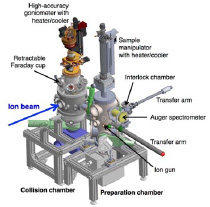The goal of this project is to investigate the interaction between highly charged ions (HCI) and magnetic 2D materials and surfaces with a completely new approach with respect to the present available methods.
The wider research context includes the study of collisions of ions with matters at low energy (less than the nuclear barrier), an interdisciplinary research field that involves both atomic and solid-state physics.
The interaction between HCI and surfaces started in the ’90s and has been deeply investigated since then. Several theoretical frameworks have been developed in the past, which includes quantum and semi-classical approaches.
Nevertheless, only few studies have been accomplished with surfaces that present some defined magnetic order, as magnetic domains of a ferromagnetic phase.
During a grazing collision, slow HCI capture electrons in highly excited states from the very first atomic layers that could be in particular magnetic phase.

Schematic of the ion – magnetic surface interaction. © INSP
The working hypothesis is that the subsequent electron and photon emission bears the fingerprint of the local spin-ordering of the sample allowing for characterizing the magnetic properties of the sample.
The ability to detect the presence of a ferromagnetic ordered phase in ion–surface interaction, even with no external magnetic field applied, was demonstrated in the past using Auger spectroscopy.
In these first attempts, a qualitative evidence was obtained only and a dispute arose in the scientific community about the general applicability of Auger spectroscopy.
Theoretical studies could not clarify this controversy.
At present, the research questions are: can we characterize the first atomic layer magnetism with HCI collision? Can this technique be used for investigations of magnetic properties of the first atomic layers and magnetic 2D materials?
The objective of this project is to provide answers to these questions with a new approach that will avoid problems of Auger spectroscopy.
We propose a new method where emitted X-ray photon, of Auger electrons, and ion charge state (and eventually energy loss) after the collision are simultaneously detected to characterize the collisional dynamics, which can provide quantitative information on the surface magnetization.
The high level of originality of the proposed method will open a new route to detect magnetic properties of the first or unique layers of samples. It will open an innovative way to detect the presence of antiferromagnetic phases, which is elusive with the current technologies.
The union of the complementary expertise of the two primary researchers involved from the INSP (X-ray spectroscopy) and TUW (ion and electron spectroscopy) will bring a novel alternative for the magnetization determination of surfaces or 2D materials.

Preparation and interaction chambers of the set-up in Paris. © INSP
The expertise of these two groups will be accompanied and completed by external collaborators for the theoretical treatment of the collisions and atomic cascades, and for the characterization and production of benchmark materials.

